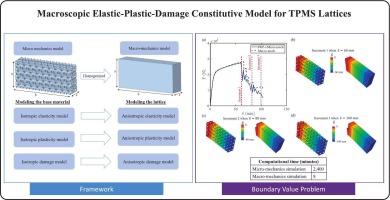TPMS晶格的宏观弹塑性损伤本构模型
IF 3.8
3区 工程技术
Q1 MECHANICS
International Journal of Solids and Structures
Pub Date : 2025-09-17
DOI:10.1016/j.ijsolstr.2025.113663
引用次数: 0
摘要
基于三周期最小表面(TPMS)的晶格是一类结构细胞材料,由于其普遍的多功能特性和增材制造技术的进步,近年来引起了人们的极大关注。然而,当TPMS晶格用于各种结构的网格化以增强力学性能时,明确建模的计算成本很高。本文首次提出了一个宏观本构模型,该模型可以预测基于TPMS板材的晶格体各向异性弹塑性损伤响应,并使用有限元方法进行了数值实现。提出的宏观本构模型由三次对称弹性模型、基于关联流动规则的各向异性希尔塑性屈服面修正模型和各向异性损伤模型组成,其中塑性模型和损伤模型均考虑了拉伸和压缩加载条件下晶格的不对称行为。通过对相对密度为28%的Schoen’s I-WP片基TPMS晶格(IWP-s)和相对密度为25%的Neovius片基TPMS晶格(NEOV-s)在不同多轴加载条件下的弹塑性损伤行为进行预测,验证了所建立的宏观本构模型,得到了宏观模型与显式细观力学模型非常吻合的结果。此外,在一个由均匀分布的基于TPMS片的网格组成的悬臂梁问题上进行了验证,发现网格梁的弹性和弹塑性损伤响应与宏观模型对ipp -s和NEOV-s的预测非常吻合,同时节省了约2778倍的计算时间。这种宏观连续体建模框架有助于开发计算上有效的各种晶格超材料的弹塑性损伤耦合本构模型。本文章由计算机程序翻译,如有差异,请以英文原文为准。

Macroscopic elastic-plastic-damage constitutive model for TPMS lattices
Lattices based on triply periodic minimal surfaces (TPMS), which are a class of architected cellular materials, have attracted significant attention lately, due to their prevailing multifunctional properties and due to the advancements in additive manufacturing technologies. However, TPMS lattices are computationally expensive to model explicitly when used in latticing various structures for enhanced mechanical properties. This study presents for the first time a macroscopic constitutive model that can predict the bulk anisotropic elastic–plastic-damage response of TPMS sheet-based lattices, including its numerical implementation using the finite element method. The proposed macroscopic constitutive model consists of a cubic symmetric elasticity model, a modified version of anisotropic Hill’s plasticity yield surface with an associative flow rule, and an anisotropic damage model such that both the plasticity and damage models account for the asymmetric behavior of lattices under tension and compression loading conditions. The developed macroscopic constitutive modeling is validated through predicting the elastic–plastic-damage behavior of the Schoen’s I-WP sheet-based TPMS lattice (IWP-s) at 28% relative density and Neovius sheet-based TPMS lattice (NEOV-s) at 25% relative density under various multi-axial loading conditions, where a very good match is obtained between the macroscopic models and the explicit micro-mechanics models of the lattices. In addition, validation is done on a cantilever beam problem that consists of homogenous distributions of TPMS sheet-based lattices where a very good match is found between the latticed beam’s elastic and elastic–plastic-damage responses and the macroscopic models’ predictions for both IWP-s and NEOV-s, while saving about 2778 times the computational time. This macroscopic continuum modeling framework helps in the development of computationally effective coupled elastic–plastic-damage constitutive models for various types of lattice metamaterials.
求助全文
通过发布文献求助,成功后即可免费获取论文全文。
去求助
来源期刊
CiteScore
6.70
自引率
8.30%
发文量
405
审稿时长
70 days
期刊介绍:
The International Journal of Solids and Structures has as its objective the publication and dissemination of original research in Mechanics of Solids and Structures as a field of Applied Science and Engineering. It fosters thus the exchange of ideas among workers in different parts of the world and also among workers who emphasize different aspects of the foundations and applications of the field.
Standing as it does at the cross-roads of Materials Science, Life Sciences, Mathematics, Physics and Engineering Design, the Mechanics of Solids and Structures is experiencing considerable growth as a result of recent technological advances. The Journal, by providing an international medium of communication, is encouraging this growth and is encompassing all aspects of the field from the more classical problems of structural analysis to mechanics of solids continually interacting with other media and including fracture, flow, wave propagation, heat transfer, thermal effects in solids, optimum design methods, model analysis, structural topology and numerical techniques. Interest extends to both inorganic and organic solids and structures.

 求助内容:
求助内容: 应助结果提醒方式:
应助结果提醒方式:


